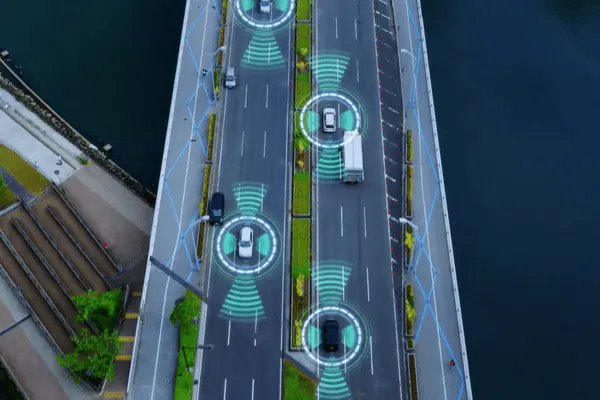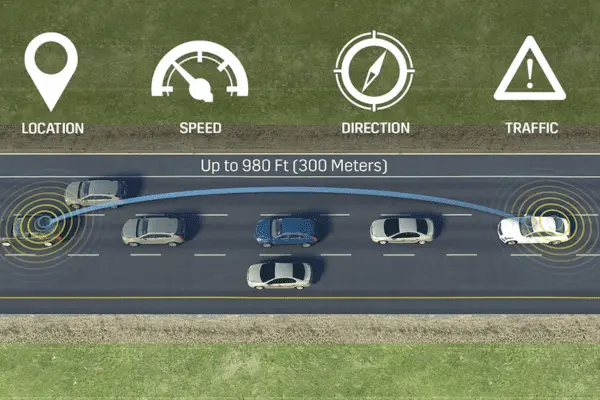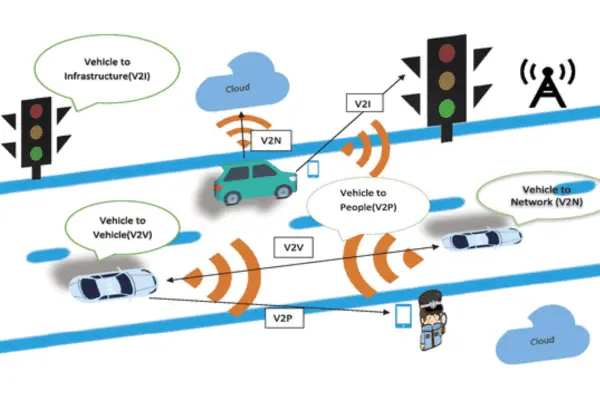Introduction to V2V communication
Vehicle Control Units (VCUs) and Vehicle-to-Vehicle (V2V) communication are key components in forming this revolutionary environment as the automotive industry moves closer to a future of linked and autonomous vehicles. Modern cars’ brains, or VCUs, perform several vital tasks. Additionally, vehicle-to-vehicle (V2V) connectivity enables vehicles to share real-time data, enhancing overall driving pleasure, efficiency, and safety.
This blog explores the role that VCUs and V2V communication play in mobility, as well as the technology that underpins it.
1. The Evolution of Control Units for Vehicles
Vehicle control units, or VCUs, are now integral components of modern cars, serving as the hub for a variety of vehicle operations. VCUs evaluate data from several sensors and systems, enabling flawless coordination of powertrains, brakes, steering, and other systems. As technology has advanced, VCUs’ ability to incorporate more complex functions has expanded, making them crucial elements in the integration of cutting-edge technologies like autonomous driving and vehicle-to-vehicle communication.
2. Comprehending Communication from Vehicle to Vehicle (V2V)
Real-time data transmission between moving automobiles is known as car-to-car (C2C) communication, often referred to as vehicle-to-vehicle (V2V) communication. Through this wireless data interchange, vehicles can exchange information about their position, speed, direction, acceleration, and brakes. By creating a network of connected automobiles that can “talk” to one another, vehicle-to-vehicle communication significantly improves both traffic efficiency and road safety.

3. The Vehicle Control Units (VCUs) and V2V Communication Technology VCUs:
- Vehicle Control Units (VCUs): VCUs rely on powerful microprocessors and complex software algorithms for their technology. A vehicle’s sensors, cameras, and radars are just a few of the parts that provide input to VCUs. They process this data to expedite decision-making, enhance vehicle performance, and safeguard occupants and other road users.
- Dedicated Short-Range Communication (DSRC): The primary technology used for V2V communication is DSRC, also referred to as Dedicated Short-Range Communication. It works on a certain frequency spectrum and enables fast and secure data transfer between cars within a given range, often a few hundred meters. DSRC guarantees low latency, allowing real-time communication for critical safety applications.
- Cellular Vehicle-to-Everything, or C-V2X: Another V2V communication technique called C-V2X transfers data across existing cellular networks. Its advantages include the capacity for over-the-air software updates, a larger connection range, and higher data speed. More sophisticated V2X applications, like communication between cars and infrastructure (V2I) and pedestrians (V2P), may be made possible by C-V2X in addition to V2V.
4. The Role of VCUs in V2V Communication
To make vehicle-to-vehicle (V2V) communication possible, VCUs are necessary. They act as the central point for managing and connecting V2V data to other car systems. The VCU receives V2V signals, processes the data, interprets it, and makes decisions based on data from neighboring automobiles. These options include changing the speed of the car, applying the brakes, or warning the driver.
The VCU is necessary to preserve data confidentiality and integrity during a V2V connection. It verifies incoming messages, prevents spoofing, and ensures that the vehicle’s behavior is influenced solely by trustworthy and dependable V2V data.

5. Advantages of V2V Communication Enabled by VCUs Enhanced Security:
Cars can communicate about intentions such as lane changes and sudden braking through vehicle-to-vehicle (V2V) communication. This common knowledge reduces the likelihood of accidents and improves overall road safety by enabling automobiles to anticipate and respond to potential dangers.
- Crossroads Safety: V2V communication facilitates better traffic flow and reduces congestion at intersections by enabling cars to share information about their positions and intentions. For example, vehicles can cooperate to determine the most efficient paths through intersections without the assistance of traffic signals.
- V2V communication helps drivers prevent collisions by alerting them to any hazards that might be out of their direct line of sight. When faced with an emergency, V2V-enabled vehicles can take proactive steps to avoid collisions, such as autonomous emergency braking.
- Traffic Efficiency: Vehicle-to-vehicle (V2V) communication can enhance traffic flow by synchronizing vehicle speeds and merging patterns. Because of the decrease in traffic and increase in fuel efficiency, this is advantageous to both drivers and the environment.
- Coordination of Emergency Services: In the event of an accident or emergency, vehicle-to-vehicle communication can alert nearby vehicles and emergency services, guaranteeing prompt assistance and swift action.
6. Integration Challenges between VCU and V2V
Even though combining VCU and V2V communication has many advantages, there are a few problems that still need to be fixed:
- Standardization: The success of V2V communication depends on a standardized communication protocol. A network needs to be compatible with many automakers and V2V technologies to function well.
Cybersecurity and data privacy are problems brought about by the combination of VCUs and V2V communication. Ensuring secure communication links and protecting V2V data from unauthorized access or change is imperative. - Infrastructure Requirement: For V2V communication to be widely used, a sizable and comprehensive infrastructure—including cellular networks and roadside units—is needed. The development and implementation of such infrastructure can present financial and logistical challenges.
- Acceptance by Drivers: Drivers must understand and be able to accept vehicle-to-vehicle communication. Drivers need to trust the technology and be ready to cooperate with other linked cars for the system to work.

7. Real-world implementations and Prospects
There are now multiple pilot programs for V2V communication using VCUs in various parts of the world. Several countries, including the US, Japan, and Europe, have conducted successful trials of V2V communication, and these areas are currently actively exploring its possible benefits.
As technology advances, VCU capabilities will increase, and V2V communication will become more intricate. In the future, it is expected that vehicle-to-vehicle communication and other V2X (vehicle-to-everything) applications will be widely used, creating a huge network of interconnected infrastructure and vehicles.
Conclusion
Integrating Vehicle Control Units with Vehicle-to-Vehicle communication is a critical first step toward a safer, more efficient, and networked transportation future. The VCUs found in modern cars act as the brain, enabling fast decision-making and the synchronization of essential vehicle functions. When V2V communication is used, vehicles can communicate, share information, and convey intentions with one another while moving in a safe and tranquil environment.
As VCU and V2V technologies develop, they can completely transform driving experiences for people worldwide, enhance traffic flow, and redefine road safety. To fully reap the benefits of VCU and V2V integration, cooperation between industry players, lawmakers, and researchers is required to resolve issues and pave the road for a smooth and intelligent transportation environment.
Write to info@dorleco.com to learn more about our software development capabilities for battery-specific requirements and to have a look at our top-notch VCU goods and services if you’re searching for the best VCU manufacturer and supplier with VCU testing and validation.

